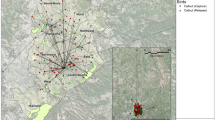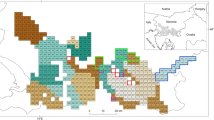Abstract
In this study, we investigated what problems urban marmosets (Callithrix penicillata) face in a city environment through the analysis of responses to callouts (N = 348) made by the environmental police of Belo Horizonte, Minas Gerais, Brazil, in the period from 2002 to 2007. Our objective was to characterise the problems faced by the marmosets and human city dwellers. The environmental police responded to two types of callouts: (1) solicitation whereby a person called them to report a problem (N = 218); and (2) the report of a hurt or injured animal (N = 127). On average, one callout per week was made in relation to urban marmosets. We found no time of year effects in relation to callouts, or any effect of gender or age of the person making the callout (P > 0.05). Furthermore, we found no environmental (e.g. percentage of “green area”) or socioeconomical variables (e.g. salary levels) of the city’s administrative regions associated with callouts (P > 0.05). The majority of callouts resulted in the attempt to capture marmosets (N = 345), and usually, only one animal was captured (N = 309). Many of these animals were released into city forest fragments (N = 146). Some sick animals were sent to veterinary clinics (N = 25) whereas others or confiscated animals were sent to the government’s wildlife processing centre (N = 143). From this data, we were able to make a series of recommendation about how the management of urban marmosets could be improved.

Similar content being viewed by others
References
Alberts AC, Oliva ML, Worley MB, Telford SR, Morris PJ, Janssen JL (1998) The need for pre-release health screening in animal translocations: a case study of the Cuban iguana (Cyclura nubila). Anim Conserv 1:165–172
Almeida AMF (2001) The formation of the elites in Sao Paulo. Soc Sci Inform 40:585–606
Bicca-Marques JC (2009) Outbreak of yellow fever affects howler monkeys in southern Brazil. Oryx. Journal of Fauna and Flora International 43:173–173
Borges RC, Oliveira A, Bernado N, Costa RMMC (2006) Diagnóstico da fauna silvestre apreendida e recolhida pela polícia militar de meio ambiente de Juiz de Fora, MG (1998 e 1999). Zoociências 8:23–33
Brasil (1967) Lei nº 5.197, 3 de janeiro de 1967. Dispõe sobre a proteção à fauna e dá outras providências. Diário Oficial da União, Brasília, 5 jan. 1967.
Brasil (1998) Lei nº 9.605, 12 de fevereiro de 1998. Dispõe sobre as sansões penais e administrativas derivadas de condutas e atividades lesivas ao meio ambiente, e da outras providências. Diário Oficial da União, Brasília, 13 Fev. 1998.
Casey A, Krausman P, Shaw W, Shaw H (2005) Knowledge of and attitudes towards Mountain Lions: a public survey of residents adjacent to Saguaro National Park, Arizona. Hum Dimens Wildl 10:29–38
de Azevedo FCC, Murray DL (2007) Evaluation of potential factors predisposing livestock to predation by jaguars. J Wildl Manage 71:2379–2386
Decanini DP, Macedo RH (2008) Sociality in Callithrix penicillata: I. Intragroup male profile. Int J Primatol 29:433–447
Decker DJ, Chase L (1997) Human dimensions of living with wildlife—a management challenge for the 21st century. Wildl Soc Bull 25:788–795
Develey PF, Peres CA (2000) Resource seasonality and the structure of mixed species bird flocks in a coastal Atlantic forest of southeastern Brazil. J Trop Ecol 16:33–53
Dowle M, Deane E (2009) Attitudes to native bandicoots in an urban environment. Eur J Wildl Res 55:45–52
Faria DS (1986) Tamanho, composição de um grupo social e a área de vivência (homerange) do sagüi Callithrix jacchus penicillata na mata ciliar do Córrego Capetinga, Brasília, DF. In: de Mello MT (ed) A Primatologia no Brasil—2. Sociedade Brasileira de Primatologia, Brasília, pp 87–105
Faulkes CG, Arruda MF, Monteiro da Cruz MAO (2003) Matrilineal genetic structure within and among populations of the cooperatively breeding common marmoset, Callithrix jacchus. Mol Ecol 12:1101–1108
Fróes AP (2006) Micos vivendo em ilhas verdes num mar de concreto: fatores que influenciam a distribuição de Callithrix penicillata (mico-estrela) em parques urbanos de Belo Horizonte. Dissertation. Pontifical Catholic University of Minas Gerais, Brazil
Fuller RA, Irvine KN, Devine-Wright P, Warren PH, Gaston KJ (2007) Psychological benefits of greenspace increase with biodiversity. Biol Lett 3:390–394
Herzog HA (2007) Gender differences in human–animal interactions: a review. Anthrozoos 20:7–21
Hill CM (2000) Conflict of interest between people and baboons: crop raiding in Uganda. Int J Primatol 21:299–315
Imam E, Yahya HSA, Malik I (2002) A successful mass translocation of commensal rhesus monkeys Macaca mulatta in Vrindaban, India. Oryx 36:87–93
Kolodinsky J, Aleong J (1990) An integrated model of consumer complaint action applied to services: a pilot study. J Consum Satisf Dissatisf Complain Behav 3:61–70
Krester HE, Sullivan PJ, Knuth BA (2008) Housing density as an indicator of spatial patterns of reported human–wildlife interactions in northern New York. Landscape Urban Plan 84:282–292
Krupart E (1985) People in cities: the urban environment and its effects. Cambridge University Press, New York
Maller C, Townsend M, Pryor A, Brown P, St Ledger L (2005) Healthy nature healthy people: ‘contact with nature’ as an upstream health promotion intervention for populations. Health Promot Int 21:45–54
McKinney ML (2006) Urbanization as a major cause of biotic homogenization. Biol Conserv 127:410–419
Menezes MOT (2004) The use of date palms (Phoenix sp.) as resting and sleeping sites by Callthrix jacchus in northeastern Brasil. Neotrop Primates 12:53–55
Miranda GHB, Faria DS (2001) Ecological aspects of black-pincelled marmoset (Callithrix penicillata) in the cerradão and dense cerrado of the Brazilian central plateau. Braz J Biol 61:397–404
Naughton-Treves L, Grossberg R, Treves A (2003) Paying for tolerance: rural citizens’ attitudes toward wolf depredation and compensation. Conser Biol 17:1500–1511
Ogra M, Ruchi Badola R (2008) Compensating human–wildlife conflict in protected area communities: ground-Level perspectives from Uttarakhand, India. Hum Ecol 36:717–729
Ottoni I, de Oliveira FFR, Young RJ (2009) Estimating the diet of urban birds: the problems of anthropogenic food and food digestibility. Appl Anim Behav Sci 117:42–46
Palmeira FBL, Craivshaw PG, Haddad CM, Ferraz K, Verdad LM (2008) Cattle depredation by puma (Puma concolor) and jaguar (Panthera onca) in central-western Brazil. Biol Conserv 141:118–125
Patterson ME, Montag JM, Williams DR (2003) The urbanization of wildlife management: social conflict, conflict and decision making. Urban For Urban Green 1:171–183
Peters EL, Pires PTL (2002) Legislação ambiental federal. Editora Juruá, Curitiba
PMBH (2003) D. anuário estatístico de Belo Horizonte 2003. Available via DIALOG. http://portal1.pbh.gov.br/pbh/pgedocument_visualizaconteudo_header.html?query=pp_conteudo.id=5472>. Accessed 20th October 2006
Rosatte RC, MacInnes CD (1989) Relocation of city raccoons. Proceedings of the Great Plains Wildlife Damage Conference 9:87–92
Rowe N (1996) The pictorial guide to the living primates. Pogonias Press, Rhode Island
Rylands AB, Faria DS (1993) Habitats, feeding ecology, and home range size in the genus Callithrix. In: Rylands AB (ed) Marmosets and tamarins: systematics, behaviour, and ecology. Oxford Science Publications, Oxford, pp 262–272
Sallis ESV, de Barros V, Garmatz SL, Fighera RA, Graca DL (2003) A case of yellow fever in a brown howler (Alouatta fusca) in southern Brazil. J Vet Diagn Invest 15:574–576
Schneider MC, Romijn PC, Uieda W, Tamayo H, da Silva DF, Belotto A, da Silva JB, Leanes LF (2009) Rabies transmitted by vampire bats to humans: an emerging zoonotic disease in Latin America? Rev Panam Salud Publica-Pan American Journal of Public Health 25:260–269
Singh M, Rao NR (2004) Population dynamics and conservation of commensal bonnet macaques. Int J Primatol 25:487–459
Stevenson MF, Rylands AB (1988) The marmosets, genus Callithrix. In: Mittermeier RA, Rylands AB, Coimbra-Filho A, Fonseca GAB (eds) Ecology and behavior of Neotropical primates. World Wildlife Fund, Washington, pp 131–211
Teixeira B (2009) Micos urbanos: onde eles estão? MSc Dissertation. Pontifical Catholic University of Minas Gerais. Belo Horizonte, Brazil
Teixeira CP, Azevedo CS, Mendl M, Cipreste CF, Young RJ (2007) Revisiting translocation and reintroduction programmes: the importance of considering stress. Anim Behav 73:1–13
United Nations (2007) World population prospects: the 2006 Revision Population Database. United Nations Population Division. Available via DIALOG. http://esa.un.org/unpp. Accessed 30 May 2008
Vilela SL, Faria DS (2004) Seasonality of the activity pattern of Callithrix penicillata (primates, Callitrichidae) in the cerrado (scrub savanna vegetation). Braz J Biol 64:363–370
Waite TA, Chhangani AK, Campbell LG, Rajpurohit LS, Mohnot SM (2007) Sanctuary in the city: urban monkeys buffered against catastrophic die-off during ENSO-related drought. EcoHealth 4:278–286
Wurbel H (2009) Ethology applied to animal ethics. Appl Anim Behav Sci 118:118–127
Zimmermann A, Walpole MJ, Leader-Williams N (2005) Cattle ranchers’ attitudes to conflicts with jaguar Panthera onca in the Pantanal of Brazil. Oryx 39:406–412
Acknowledgements
We would like to thank: the Environmental Police of Belo Horizonte for access to their reports, and for their cooperation in all aspects of this study, especially officers Écio and Martiniano; and IBAMA for sharing their data concerning urban marmosets with us, especially Daniel Vilela. Furthermore, we thank Dr. André Hirsch for making the map in Fig. 1. The research reported in this paper complies with all relevant Federal and State Laws of Brazil. RJY was financially supported by FAPEMIG and CNPq.
Author information
Authors and Affiliations
Corresponding author
Additional information
Communicated by F.-J. Kaup
Rights and permissions
About this article
Cite this article
Goulart, V.D.L.R., Teixeira, C.P. & Young, R.J. Analysis of callouts made in relation to wild urban marmosets (Callithrix penicillata) and their implications for urban species management. Eur J Wildl Res 56, 641–649 (2010). https://doi.org/10.1007/s10344-009-0362-4
Received:
Revised:
Accepted:
Published:
Issue Date:
DOI: https://doi.org/10.1007/s10344-009-0362-4




